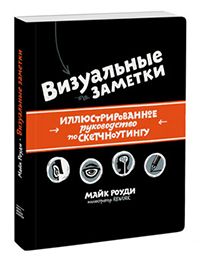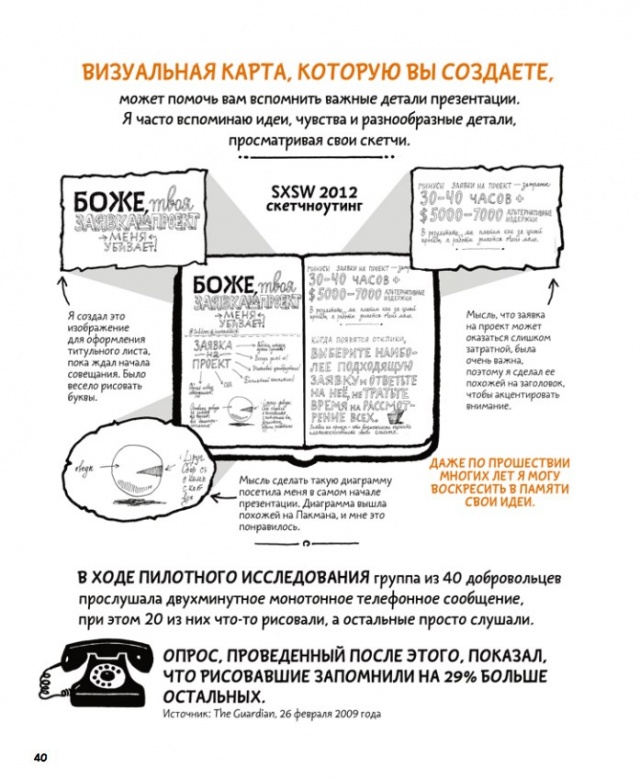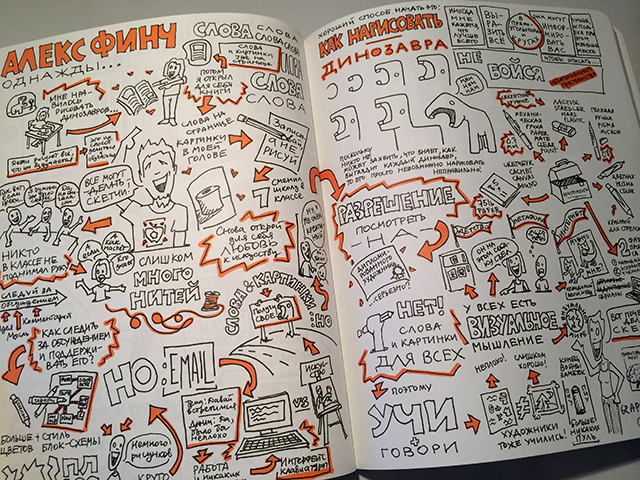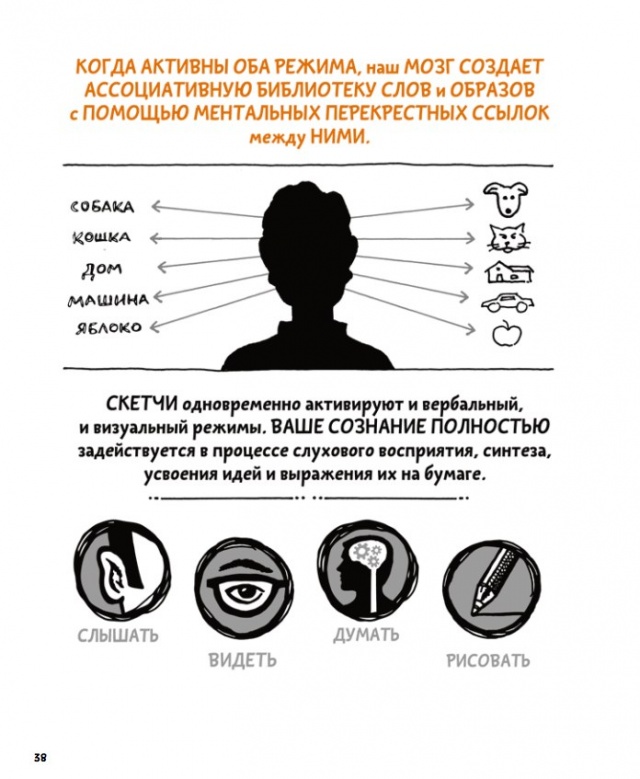Mike Rhodey “Visual Notes”
Mike Rhodey “Visual Notes”
 Sketching – this is a way of recording information, which allows not to write down 100% of the text heard (and unprepared people are unlikely to succeed at all), but, on the contrary, to highlight only the very essence of the lecturer’s entire speech and instantly record what he heard on paper. This approach allows not only to concentrate as much as possible on the presentation (in order to catch the most important details), but also hones the skill of transferring the information heard to paper using illustrations.
Sketching – this is a way of recording information, which allows not to write down 100% of the text heard (and unprepared people are unlikely to succeed at all), but, on the contrary, to highlight only the very essence of the lecturer’s entire speech and instantly record what he heard on paper. This approach allows not only to concentrate as much as possible on the presentation (in order to catch the most important details), but also hones the skill of transferring the information heard to paper using illustrations.
As a confirmation of his words that sketching is, firstly, a very interesting way of recording information, and, secondly, absolutely anyone can master it, Mike Rhodey invited 15 of the world’s most famous sketching machines to make them very quick and easy talked about themselves or their hobby. By the way, the statement that anyone can master a schematic image to convey information, you may have previously met in Dan Roehm’s books: “Visual Thinking” and “Blah-blah-blah.”
Who is this book for
Mike Rhodey’s book is written for everyone who can scribble with a pen on paper. The author will describe in great detail all the stages of creating a sketch, all possible options for arranging information, and also give advice on which tools to use in which case (sometime it is better to use a pencil, and sometime a pen). As a result, after reading this book and a little practice, you will be able to create your own sketches using unique fonts, decorative elements, as well as visual images to quickly take notes of absolutely any information.

My attitude to sketches
After reading the book, as well as after studying examples of sketches of guests invited by the author, I got an ambiguous impression. On the one hand, Mike Rhodey himself claims that he uses sketches to quickly write down useful phrases of the speaker, listen to him more attentively, and also so that at home he could re-read his notes and refresh his memory of the lecture or speech he listened to.
However, some sketches, such as Alex Finch’s story about how he started drawing, I would not use as an example of sketching in the book:

Yes, I don’t argue, this is a sketch, but I don’t like it. Perhaps this particular sketch is a vivid example of how not to do it, however, the author does not comment on his work in any way, but only says that the “technique” of text arrangement, which was used by Alex Finch, is called “popcorn”. Very valuable information, I admit it, but, in my opinion, it can also be called a non-design term – ad!
It’s one thing to draw a sketch like this, but it’s quite another to understand it. What if, you are creating a sketch not only for yourself, but also for an outside audience? Without you, no one will understand such a “note” …
Practical application of the book
Even if you do not plan to use the writing method outlined in the book in the future, you will somehow master some principles that can be applied in design: modular grids, managing the reader’s attention, arranging elements, emphasizing attention, etc.

Also, a whole chapter devoted to the practice of sketching became a pleasant surprise for me – the author suggests drawing some simple objects directly on the pages of the book: houses, cars, trees, tables, and the like. Previously, I met such an approach to the study of the material only in the book of Gene Zelazny “Speak in the language of diagrams.”
Output
The book itself is written in a very interesting way: the style is consistent – on the pages of the book the author uses only sketches to convey both text and graphic information; interesting information – if you have not previously been involved in the creation of sketches, then many of the facts set forth in the book will be of interest to you; useful tips – if you are reading this book to broaden your horizons, then even in this case, you will find a lot of new and useful information for yourself.
Where could I buy
You can buy the book in the Ozon online store or in any offline store.
Download
Introduction
Part 1
Part 2
…

